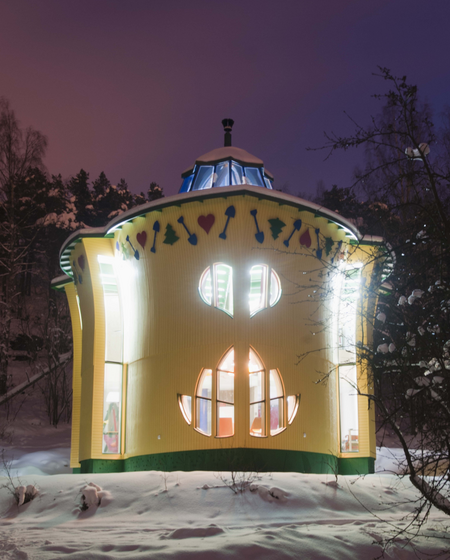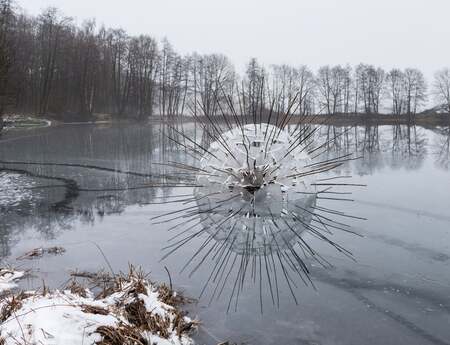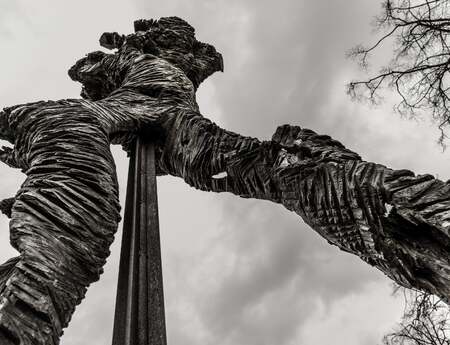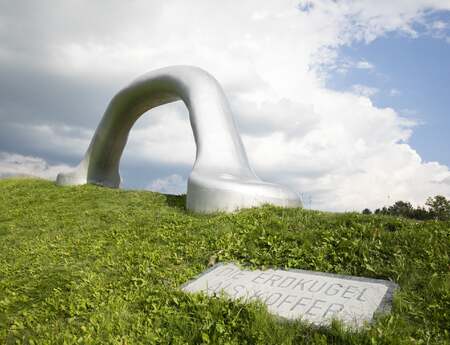Jan-Erik Andersson: die Form folgt dem Spaß
In einem Gespräch mit zwanzig bedeutenden zeitgenössischen Künstlern untersucht John K. Grande in seinem neuen Buch "Art, Space, Ecology" die endlose Beziehung zwischen Kunst, Natur und Wissenschaft. Ein Interview mit dem finnischen Künstler Jan-Erik Andersson.
Das Gesamtkunstwerk des finnischen Künstlers Jan-Erik Andersson, ein blattförmiges Haus (Life on a Leaf / Leben auf einem Blatt), das seiner Familie in Turku als Zuhause dient, entsprang einer Idee aus dem Jahre 1999. Es entstand in Zusammenarbeit mit dem Architekten Erkki Pitkäranta, mit dem Andersson viele Jahre unter dem Namen Rosegarden Art & Architecture gemeinsam tätig war. Das Haus ist das Hauptwerk von Anderssons Dissertation im Bereich der Schönen Künste an der Akademie der Schönen Künste in Helsinki. Mit dem Gebäude untersucht Andersson auf kreative Weise verschiedene Themen, die sich mit Kunst und Architektur sowie mit Häusern und deren Umgebung beschäftigen: Kann man in einem Gemälde oder einer Skulptur wohnen? Auf welche Weise kann die Natur stückweise in ein Haus hineingenommen werden? Kann man bei einem Gebäude, das auf Geschichten und Formen basiert, wie beispielsweise auf einem Blatt, einer Glockenblume oder auf einer brasilianischen Fähre, immer noch von Architektur sprechen? Warum gibt es nicht mehr Häuser, die wie Blumen, Hüte oder Schuhe geformt sind?
Neben Kurt Schwitters, Le Corbusier, Antoni Gaudi, Bruce Goff, Konstantin Melnikov, Hundertwasser, Archigram und Rem Koolhaas wurde Andersson auch von der schwedischen Kinderbuchautorin Elsa Beskow inspiriert. In ihren Geschichten gibt es Häuser, die die Form von Hüten oder Regenschirmen haben. Sein eigenes Haus basiert auf einer Geschichte, die Andersson selbst verfasste und in der es um ein Blatt geht: Der Schriftsteller August Strindberg (der auch Maler war), malte in Vita Bergen in Stockholm als ein Farbklecks auf ein Blatt fiel. Das Blatt wurde vom Wind nach Turku getragen. Dort landete es auf dem Fenstersims eines Schlosses, in dem König Erik IV. gefangen gewesen war. (Eine kleine Zeitreise!) Der König malte ein Herz auf das mit Kondenswasser überzogene Fenster und dann flog das Blatt weiter und landete … dort, wo Anderssons Haus (Leben auf einem Blatt) zu finden ist! Eines der dauerhaften Themen, mit denen sich Andersson in den 30 Jahren seines künstlerischen Daseins befasste, ist die Untersuchung und das Hinterfragen der Grenzen zwischen farbenfroher und ikonischer Ästhetik, die Erwachsene für Kinder erschaffen, und der nüchternen Ernsthaftigkeit, die normalerweise mit der visuellen Kultur Erwachsener verbunden wird.
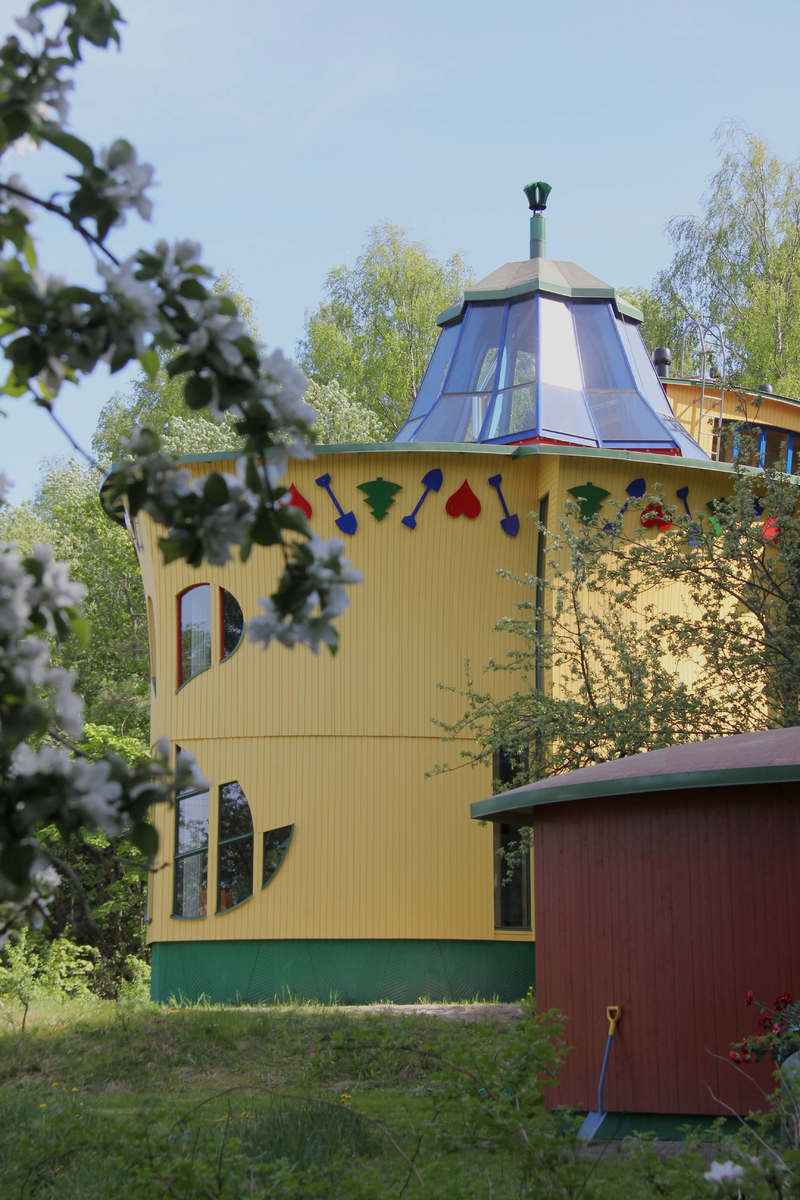
Das Haus inspirierte ein Dutzend von Anderssons Künstlerfreunden dazu, Gedichte zu verfassen und Kunstwerke zu gestalten, die in das Gebäude integriert wurden: Elemente des Bodens und der Wände, eine laminierte Küchenoberfläche, Tapete, Lampen, Videokunst im Boden, Tische und Bänke im Freien, ökologische Überlegungen und eine Klanginstallation im Geländer, die auf Veränderungen des Windes und des Lichtes reagiert. Andersson erklärt, dass dadurch die Freunde der Familie allgegenwärtig sind. Es betont aber auch die sozialen und gemeinschaftlichen Aspekte des Hauses, denn das Haus ist keine verschlossene Privatangelegenheit. Stattdessen ist es ein Ort, an dem sich Menschen mit verschiedenen Gedanken und ästhetischen Ansichten treffen und zusammenarbeiten können.
Dies wird auch an der Inneneinrichtung deutlich. Moderne Elemente, wie beispielsweise die sechs Meter hohe, kurvige weiße Wand, werden mit überaus reich verzierten Böden, Küchenschränken von Ikea und Mosaikwerken verknüpft. All das sind Zusammenarbeiten der Familienmitglieder. Alle Waschbecken, Toiletten und Badewannen stammen von Wertstoffhöfen. Geheizt wird das Haus mit einem thermischen System.
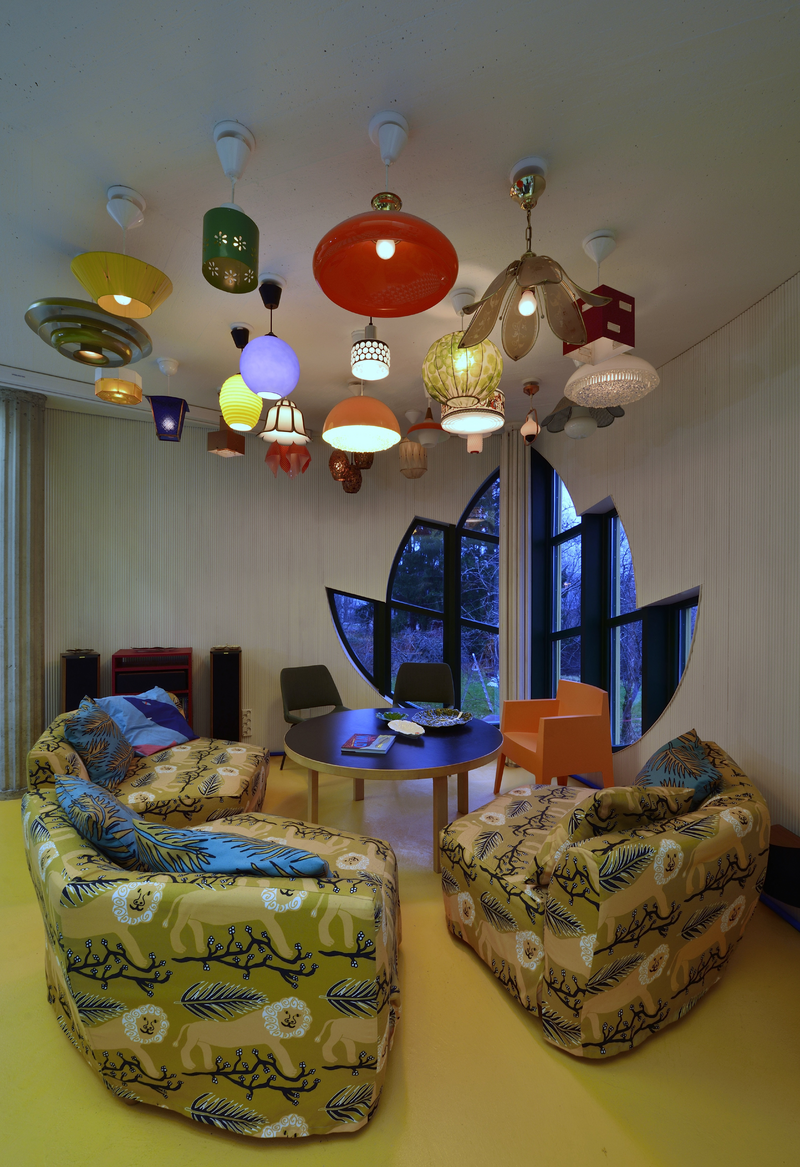
JKG: Hier sind wir also bei dem Blatt-Haus auf einer Insel in Turku, Finnland. Was ich hier sehe, ist eine wirklich erlesene Mischung aus künstlerischer Initiative und ortsansässigen Ideen, die zu einem voll funktionstüchtigen vertikalen Zeichen nicht konformer Architektur verbunden wurden. Mit anderen Worten: Es handelt sich um Architektur, die eine Sprache bildet und die Sprache selbst ist Teil der Geschichte.
Manchmal dient ein Haus als Grundlage für eine Geschichte, aber in diesem Fall führte die Geschichte zum Haus! Jan-Erik, Sie erwähnten, dass dieses Blatt-Haus auf einer Geschichte beruht. Könnten Sie mir ein etwas über diese Geschichte erzählen … über diese allegorisch-räumliche Verbindung von Literatur und Kunst?
J-AE: Der berühmte Schriftsteller August Strindberg malte in Vita Bergen in Stockholm im 19. Jahrhundert. Er malte ein Blatt, dieses entwischte der Leinwand und flog über das Wasser nach Turku, Finnland. Es reiste einige hundert Jahre zurück in der Zeit und landete auf dem Fenstersims des Schlosses, in dem König Erik IV. im 16. Jahrhundert gefangen war. Erik erschuf wunderbare Zeichnungen im Gefängnis von seiner Verlobten Karin Mansdotter. Er saß dort und sah die Blattform außen am Fenster, also malte er ein Herz ans Fenster. Das Blatt draußen flog fort und landete andernorts und nun kann man sehen, dass es tatsächlich hier gelandet ist, wo das Blatt-Haus steht. Man kann von hier sogar das Schloss sehen. Das liegt daran, dass die Stadt Turku, als sie beschloss, dass sie dieses Projekt umsetzen möchte, diese Geschichte berücksichtigte. Es ist so aufregend, dass all dies geschehen ist.
Und dann gab es noch die schwedische Geschichtenerzählerin Elsa Beskow, deren illustrierte Bücher Ihre Konzeption und die Gestaltung des Blatt-Hauses beeinflussten …
J-AE: Beskow hat einige unglaubliche Geschichten verfasst. In einer dieser Geschichten brennt eine kleine Stadt nieder. Ein reicher Mann, der dort gelebt hatte, als er jung war, erklärt sich bereit, für den Wiederaufbau der Stadt zu bezahlen. Allerdings unter einer Bedingung: Jeder soll ein individuelles Haus bauen. Ein Regenschirmhaus für den Schirmmacher, ein Kuchenhaus für den Bäcker, ein Huthaus für den Hutmacher … mir gefielen einige von Beskows Illustrationen zu diesen Häusern so gut, dass sich mir die Frage stellte, warum Häuser nicht häufiger so fantastisch und persönlich sein können. Jahrzehnte später baute ich, gemeinsam mit dem Architekten Erkki Pitkäranta, ein Haus in Blattform mit einer Glockenblume. Das Blatt-Haus wurde zum „Produktionswerk“ meiner Dissertation an der Akademie der Schönen Künste in Helsinki. Da ich einen Kontext für mein Blatt-Haus suchte, kuratierte ich die Ausstellung Wild des Turku Stadt Kunstmuseums. Der Fokus der Ausstellung lag auf Fantasie und Architektur.
Die Ausstellung Wild zeigte auch original Wasserfarbenillustrationen von Elsa Beskow. Zusätzlich wurden Figuren und Dokumentationen professioneller Architekt*innen, Designer*innen und Künstler*innen gezeigt, wie zum Beispiel: Jersey Devil, Douglas Cardinal, Rem Koolhaas, Vito Acconci, Will Alsop. Ihnen wurden weniger konventionelle, eher organische Baumeister gegenübergestellt: 24H, Antonio Gaudi, Hubbell & Hubbell, Mariko Mori, FAT, Marko Kaiponen, Riikka Kappi, Kim Adams und Eugene Tsui. Eine wunderbare Inspiration für kreative und an Design interessierte Menschen!
J-EA: Ja, das wirklich Wilde an der Ausstellung war, dass es mir gelang, große Architekt*innen und Künstler*innen mit weniger bekannten, praktisch orientierteren und umweltorientierteren Künstler*innen und Baumeister*innen zusammenzubringen. Ich bin überzeugt, dass diese beiden Arten von Architektur auf demselben Niveau behandelt werden sollten und dass ein Dialog zwischen ihnen eine viel lebenswertere Umwelt hervorbringen würde.
Wild war eine Übung in Demokratie!
J-EA: Natürlich! Warum sind Architekt*innen diejenigen, die entscheiden, was guter Geschmack ist? Gebäude sind ein großer Bestandteil unseres Lebens und beeinflussen daher stark unsere ästhetischen Wahrnehmungen. Architekt*innen entscheiden, was gut ist und was nicht. Ich mag es nicht, dass Architekt*innen diese Art von Macht haben. Man sollte den Menschen mehr Macht darüber geben, ihre eigenen Häuser zu entwerfen. Künstler*innen sollten auf allen Ebenen unsere Gesellschaft in Planungsprozesse einbezogen werden.
Und Sie haben dies gezeigt, indem Sie Kunst als ein lebendiges Designobjekt in das Blatt-Haus integriert haben …
J-EA: Rund zwanzig Künstler*innen wurden eingeladen ihre Kunstwerke in die Strukturen des Blatt-Hauses zu integrieren, und die meisten von ihnen sind Freunde der Familie. Dies ist ein Weg, damit sie in unserer Nähe sind, auch dann, wenn sie weit weg sind. Beispielsweise Shawn Deckers Werk, das Geräusche im Geländer des Hauses abgibt, die von Temperatur und Wind abhängen. Dies war nicht das erste Mal, dass Shawn Geräusche in ein Haus integrierte. 15 Jahre lang haben wir über die Bedeutung von Geräuschen als Zierwerk für Häuser gesprochen. Gegen Ende der 1990er Jahre erschuf Shawn ein Geräuschwerk, für eine als Blume geformte Gartenbauschule, Gerbera, die Pitkäranta und ich entworfen haben. Er nutzte vorher aufgezeichnete Geräusche von 32 Vögeln, die in der Umgebung leben, aber auch andere natürliche Geräusche. Durch die sich immer wandelnden Klangmuster entsteht ein meditativer Arbeitsraum für die Schüler*innen.
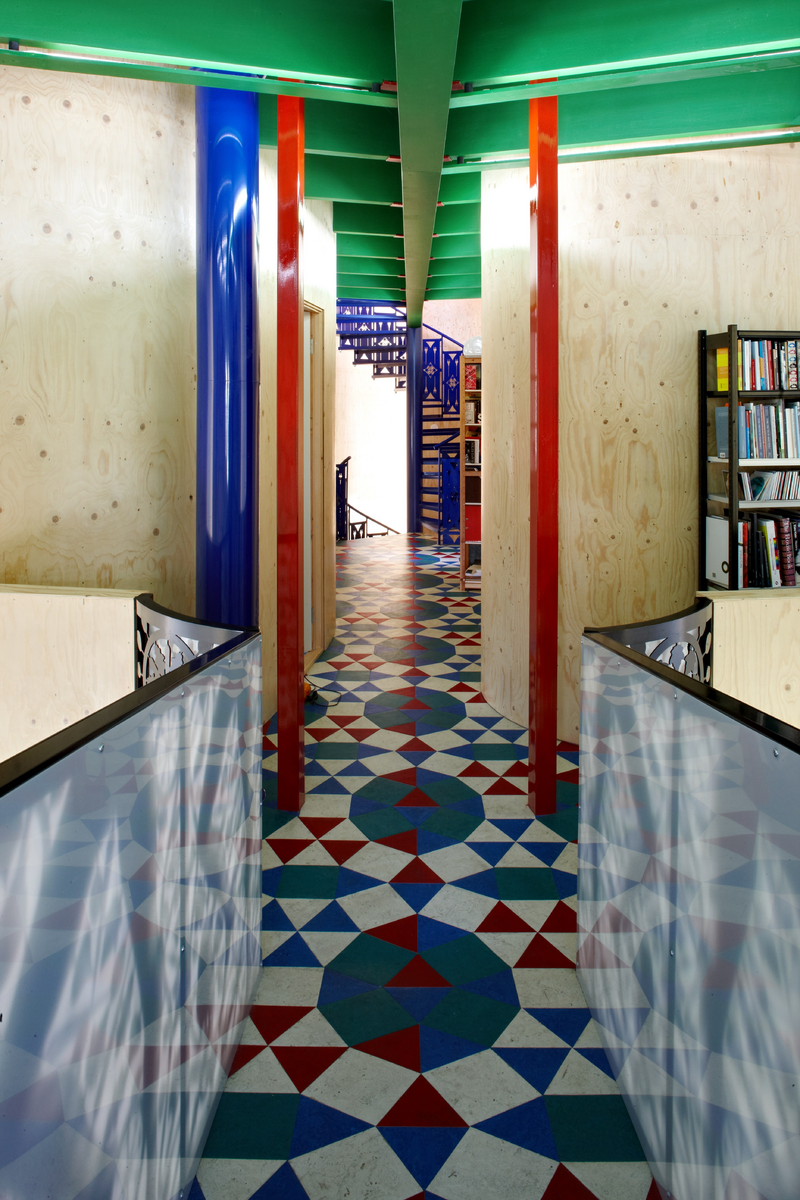
Dies ist ein Haus, bei dem Künstler*innen zur Sprache des Hauses beitragen. Das macht es etwas barock. Es gibt eine direkte Verbindung von innen und außen, eine sehr nordische Vision. Die britische Umweltkünstlerin Trudi Entwistle integrierte draußen Landschaftselemente. Susanna Peijari hat Fußstapfen und Körperteile in die Decke des Erdgeschosses integriert und Karin Andersen entwickelte die Küchenoberflächen. Der japanische Künstler Yuichiro Nishizawa hat eine sehr subtile Ergänzung in die Wände der oberen Stockwerke eingefügt. Kunst kann auch ein Detail sein, sie muss nicht dominieren. Denn als Verzierung oder Detail ist sie effektiver in ihrer integrativen Sprache. Sehen Sie das Blatt-Haus als eine Intervention für die finnische Architketurgemeinde? Denn so einen Prototyp gab es vor dem Ihren nicht in der finnischen Architektur. Sie bieten einen neuen Weg oder eine neue Richtung für die Architektur unserer Zeit an.
J-EA: Pitkäranta und ich glauben an Spielereien und Überraschungen. Wir arbeiten symbiotisch, werfen uns gegenseitig Ideen zu und wir erzählen Geschichten, und diese Geschichten beeinflussen, was wir tun werden. Wenn wir diese Geschichten erschaffen und wenn wir anfangen Pappe zuzuschneiden, beeinflusst das, wie wir etwas erschaffen und was wir erschaffen. Es ist ein sehr sicherer und warmer Weg, um Räume zu erschaffen. Es ist wichtig, dass man nicht allein in seinem Kopf haust. Es ist kein Kompromiss. Es gelang uns, etwas ganz Neues, etwas Unerwartetes zu erschaffen, das keiner von uns allein hätte vollbringen können. Den eingeladenen Künstler*innen sagten wir, dass sie nicht etwas schaffen sollen, das zur Bauweise passt, sondern etwas erschaffen sollten, was sie mochten und wir im Haus müssen dann damit leben!
Ein Zukunftsforscher sagte, dass wir in der Lage sein müssen, zurückzublicken, um nach vorne zu blicken. Ich engagiere mich dafür, dass die alten Art-Nouveau-Gebäude hier in Turku nicht weiter abgerissen werden. Ich finde es sehr wichtig, dass wir etwas von der Vergangenheit bewahren und dass wir eine Verbindung zu den Märchen, die wir als Kinder hörten, aufrechterhalten. Ich hoffe, dass die Räume, die wir erschaffen, die Fantasie beflügeln und Erinnerungen wachrufen. Ich halte diese Eigenschaften für sehr wichtig, wenn wir eine nachhaltige Zukunft erschaffen wollen.
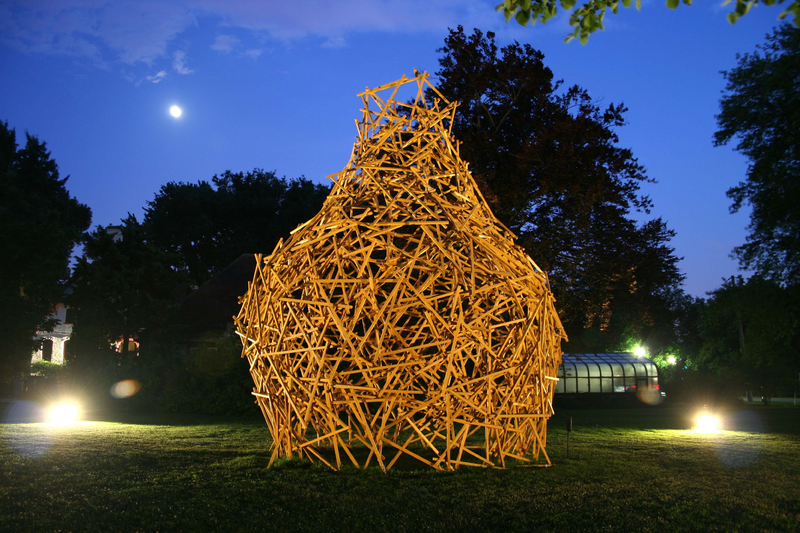
Glaubt man einer Anekdote, war Ihre Partnerin Marjo auch in den Planungsprozess des Hauses involviert.
M: Anfangs mochte ich die Idee nicht, weil ich minimalistisch bin. Aber weil ich mit Jan-Erik, der ein Maximalist ist, zusammenleben möchte, wollte ich ihm die Möglichkeit geben, seine Idee umzusetzen, wenn auch mit der Bedingung, dass ich meine eigenes Zimmer haben werde. Aber im Entstehungsprozess begann ich das gesamte Haus wertzuschätzen und nun liebe ich es, darin zu leben, auch weil es einige minimalistische künstlerische Elemente beinhaltet. Tatsächlich kann man die Art und Weise, wie wir kommunizieren, am Haus sehen!
Woher erhielten Sie die Idee des minimalistischen Denkens?
M: Ich weiß nicht, was ich dazu sagen soll. Ich habe eine finnische Seele.
J-EA: Die skandinavische Lässigkeit liegt in allen Finnen. Es ist eine Art minimalistisches Rückgrat. Es ist nicht wild und es ist auf eine gewisse Art kontrolliert.
M: Es kommt auch daher, dass wir sehr arm waren, als ich ein Kind war. Dies macht dich dahingehend reich, dass du Material wertschätzt und verstehst; das, was es ist und wie es funktioniert. Manchmal weiß man dadurch mehr.
Das Blatt-Haus stellte Menschen aus der Umgebung ein und es beinhaltete auch Pausen zwischen der Konstruktion und dem Bau, Phasen der Reflexion und des Betrachtens. Es entstand in Stücken …
J-EA: Ich las Martin Heideggers Essay Bauen Wohnen Denken. Das Denken ist der wichtigste Teil, denn man muss sich wirklich gut überlegen, was man will. Es war nie mein Traum in einem Privathaus zu wohnen. Ich hätte ohne Probleme weiterhin in unserem Mietshaus wohnen können. Wir kannten viele Leute in dem Haus, die älteren Damen halfen uns mit Adrian und solchen Dingen. Wenn man ein Haus als Projekt angeht, dann muss es mehr sein als ein privates Familienhaus, dann muss es kommunizieren!
Auch schlossen wir jeden Raum aus, den wir nicht brauchten. Da Marjo keine Gegenstände besitzen möchte, haben wir keine Garage und keinen Keller. Stattdessen erschufen wir einen Raum mit interessanten architektonischen und künstlerischen Details. Ein Raum für den Geist.
Auch wollte ich die Welt der Architektur kneifen, denn ich habe das Gefühl, dass das Konzept „Erschaffen von Architektur“ zu eng gefasst ist und sich zu sehr mit Dingen wie dem Verhältnis abstrakter Massen beschäftigt. Das gemeinsame Nachdenken mit Marjo war auch sehr kreativ. Tatsächlich hat sie ein Jahr damit verbracht, das Haus zu streichen und weiß daher mehr über die Materialien als ich. Ich denke, es ist ihr Einfluss, dass wir diese modernistischen weißen Wände haben.
Sie haben im zweiten Stock des Blatt-Hauses eine Brücke, die den Brücken in Turku nachempfunden ist. Sie sprachen darüber, dass diese Erfahrung sehr präsent war, als sie aufwuchsen …
J-EA: Das ist mir erst vor Kurzem bewusst geworden. Ich habe schon immer im Herzen Turkus gelebt und jeden Tag den Fluss überquert. Die Brücke ist ein interessanter Nicht-Ort. Natürlich war auch der Essay von Heidegger eine Inspiration, denn er verwendet die Brücke als Metapher. Die Brücke verbindet nicht nur Orte, sie erschafft auch Orte, an der Stelle, an der sie mit dem Boden in Verbindung kommt. Ich habe das Gefühl, dass die Brücke für meine Psyche sehr wichtig ist. Ich wollte, dass die Brücke zu den Schlafmöglichkeiten hinübergeht, denn wenn man sich schlafen legt, geht man auch über eine Art Brücke. Auch haben wir die Brücke so entworfen, dass sie leicht ansteigt, sodass es ein erhebendes Gefühl ist, schlafen zu gehen, und es macht es leichter morgens zu erwachen, weil man einfach die Brücke hinunterrutschen kann!
Den verschiedenen Details des Blatt-Hauses ist ein Folkloreelement inne, das mit den künstlerischen Ansprüchen und einer postmodernen Lebhaftigkeit verknüpft ist. Und genau darin liegt die so interessante Spannung des Gebäudes.
J-EA: Die Frage nach Zusammenarbeit war für mich in den vergangenen 15 Jahren sehr wichtig, denn ich wurde meines eigenen Gehirns müde. Ich arbeitete mit dem Architekten Erkki Pitkäranta, dem Klangkünstler Shawn Decker und meinen zwei Künstlerfeunden Kari Juutilainen und Pertti Toikkanen von der Performancegruppe Edible Finns zusammen. Natürlich gestalte ich – selten, aber gelegentlich – auch eigene Kunstwerke, aber das gemeinschaftliche, wie das Blatt-Haus, mag ich lieber. Dabei beteiligt man Handwerker*innen und andere Künstler*innen. Es entsteht ein großes Feld kreativer Energie. Mir gefällt die Vorstellung, dass verschiedene ästhetische Ansichtsweisen im Haus nebeneinander leben. Ich mag es zu zeigen, dass dadurch eine Harmonie entstehen kann. Denn wir alle benötigen die meditative und die expressive Seite des Lebens.
Spüren Sie Einflüsse anderer Künstler*innen wie Kurt Schwitters oder Friedensreich Hundertwasser?
J-EA: Ja, von beiden und Bruce Goff war ebenso wichtig, genauso wie Le Corbusiers kunstvollere Arbeiten.
Sie erwähnten mal, dass Architekt*innen wie Louis Sullivan und Alvar Aalto oft missinterpretiert werden.
J-EA: All diese Architekt*innen werden missverstanden. Geschichte wird von den Siegern geschrieben. Die Modernist*innen erschufen und gestalteten Geschichte in einer geraden Linie bis hin zu abstrakten weißen Oberflächen. Dafür nutzen sie das Gebot Sullivans „Form folgt der Funktion“. Louis Sullivans ursprünglicher Text sagt, dass jede Architekt'in für zwei Jahre abstrakte Massen und wie sie zusammenhängen studieren sollte, aber danach sollte jedes Gebäude verziert werden und erst dadurch entsteht wirklich Architektur. Louis Sullivan hatte eine Gabe, sehr klare Oberflächen mit sehr intensiven Verzierungen zu versehen. Dies ist es, was Historiker*innen fortrissen, und nun gibt es nur noch Masse und Funktion.
Der frühe Aalto stand der Natur und dem Organischen sehr nahe. Wenn man ihn nach den Maßen seiner Module fragte, antwortete er: Zwei Millimeter! Zum Vergleich: Le Corbusiers Module lagen bei 226 Zentimetern.
Ich bin sehr an einem Konzept interessiert, das ich „iconic space“ nenne. Das Projekt des Blatt-Hauses hat es mir ermöglicht zu analysieren, wie anders es sich anfühlt in einem Haus zu leben, das auf einem bildlichen Grundriss basiert, bildliche Verzierungen und symbolische Formen an den Fenstern hat. Ich denke, es lässt deinen Geist ganz anders fühlen, wenn du in einem solchen Haus lebst. Geschichten, die wir als Kinder erzählt bekommen oder die wir erfinden, sind wie Rückzugsorte in unserem Verstand und bleiben ein Leben lang bei uns. Ich denke, dass der ikonische Raum es uns ermöglicht, leichter mit diesen Rückzugsorten wieder in Verbindung zu treten. Ich denke, Erwachsene müssen dies tun, um Harmonie zu erreichen.
Viele Leute sagen mir, dass ich mit Kindern arbeiten sollte, aber Kinder können ein Maß an Sicherheit finden und ihre eigenen Welten erschaffen, und das zum Beispiel aus einem Pappkarton oder einer Bratpfanne! Dieses Haus ist für Erwachsene! Ich glaube wirklich nicht, dass Verspieltheit nichts Ernstes ist. Die Form kann dem Spaß folgen!
Auch in diesem belebten Raum ist Spaß zu erkennen! Sieht man aus dem Fenster, kann man das Schloss sehen, auf das Sie vorhin Bezug nahmen. Und Sie haben ein blattförmiges Fenster mit einer Art Landzunge, ganz so, als würde man aus einem Boot hinaussehen. Die Lampe ist retro und ein altes Sofa ist mit Stoff eines Textilkünstlers bedeckt, der in St. Petersburg lebt.
J-EA: Im Finnland der 1950er Jahre waren die Winter dunkel und langweilig und die wahrhaft magischen Dinge waren die Lampengeschäfte in den Städten. Ich erinnere mich, wie ich draußen stand und auf Dutzende von Leuchtern starrte. Die Lichtinstallation besteht aus 26 Second-Hand-Leuchtern und ist eine Hommage an diese Läden. Wenn Menschen hier ins Haus kommen, entdecken sie meist eine Lampe, die sie an ihre Kindheit erinnert, und das ruft Erinnerungen wach. Die meisten Möbel und die Waschbecken, Toiletten und die Badewanne sind recycelt. Wir haben recycelte alte Familienbänke und Tische, um an alte Familientraditionen anzuknüpfen. Viele Details funktionieren durch Überraschung: Es gibt im Fußboden sogar ein Video von Pierre St-Jacques, das Menschen zeigt, die wie Ameisen in der New Yorker Grand Central Station umhergehen. Natürlich ist die Integration eines solch dekorativen, aber historisch aufgeladenen Elements ein Weg Erinnerungen in bewohnten architektonischen Räume wachzurufen.
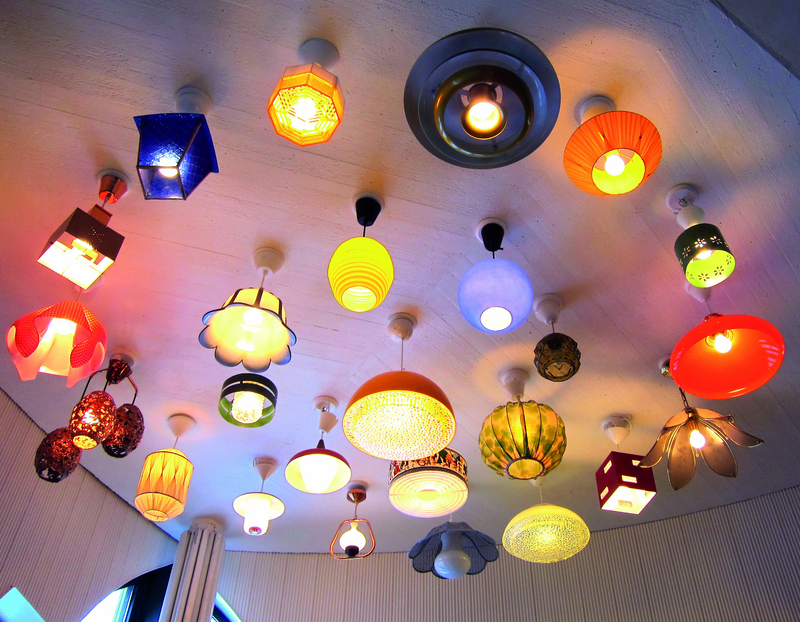
Jan-Erik, als ein lebendiges Kunstwerk, sehen Sie das Blatt-Haus als eine Skulptur oder als eine kulturelle Ikone? Wird das Zusammenstellen von symbolhaften Elementen als skulptural akzeptiert?
J-EA: Es ist interessant, dass mir im Jahr 1999, als wir das Projekt begannen, ein finnischer Architekturprofessor schrieb und sagte, dass ich das Haus nicht bauen solle, weil es eher ein Bild ist als etwas Architektonisches und dass man nicht in einem Bild leben könne! In dieser Hinsicht habe ich bewiesen, dass er Unrecht hatte! Unser Haus ist gleichermaßen ein gut funktionierendes Zuhause und ein Kunstwerk. Und ich würde es ganz gewiss auch als etwas Architektonisches bezeichnen. Und weil das Design durch ein Pappkartonmodell entstand, mit dem ich herumbastelte, das ich zurechtschnitt und mit dem ich spielte, ist der Ausgangspunkt auch in der Bildhauerei zu sehen. Aber in der Endphase des Projekts, als es darum ging, all die farbigen Oberflächen und Details zum Harmonieren zu bringen, da dachte und verhielt ich mich eher wie ein Maler. Tatsächlich mag ich die Situation der Ungewissheit, dass ich nicht recht weiß, worin wir leben! Es ist sehr kreativ.
Und Sie erdachten und bauten folgendes Projekt, gemeinsam mit dem Architekten Erkki Pitkäranta im Jahr 1997: Das Cumin Cow House/Barn, das dazu gedacht war, dass Kühe darin leben.
J-EA: Es war der Geruch von Käse und Kreuzkümmel und Milch, der das Projekt entstehen ließ! Das Cumin Cow House war als eine ökologische Art Milch zu produzieren gedacht, mit den Kühen im Blick. Wir dachten daran, eine sinnenfreudige, fantasiereiche Architektur zu erschaffen, die das Seelenleben der Kühe spiegelt. Wir fragen die Bauern: „Welche Farben mögen Kühe bei Blumen?“ Und so ging es weiter und weiter. Anfangs starrten uns die Bauern nur an, aber nach einer Weile dachten sie ernsthaft darüber nach. Kühe lieben es beispielsweise in einem Wald zu sein, daher erschufen wir im Cow House einen Wald aus alten Telefonmasten. Außerdem sind es sehr soziale Tiere, daher stellten wir die Nachkommen in den Mittelpunkt. Wir dachten uns einen Raum in der Mitte für die Kälber aus, und die älteren Kühe können um sie herumstehen und sie ansehen. Und der Raum war kreuzkümmelförmig, weil wir erfuhren, dass Kühe im Wald gerne wilden Kümmel essen.
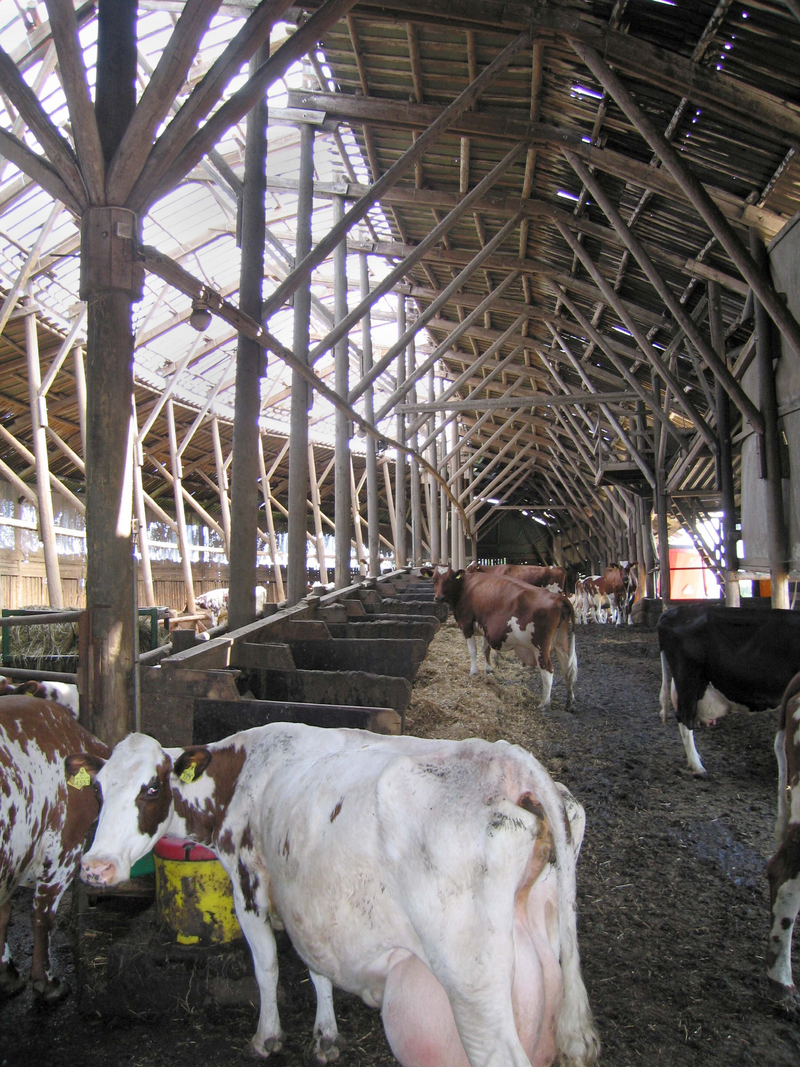
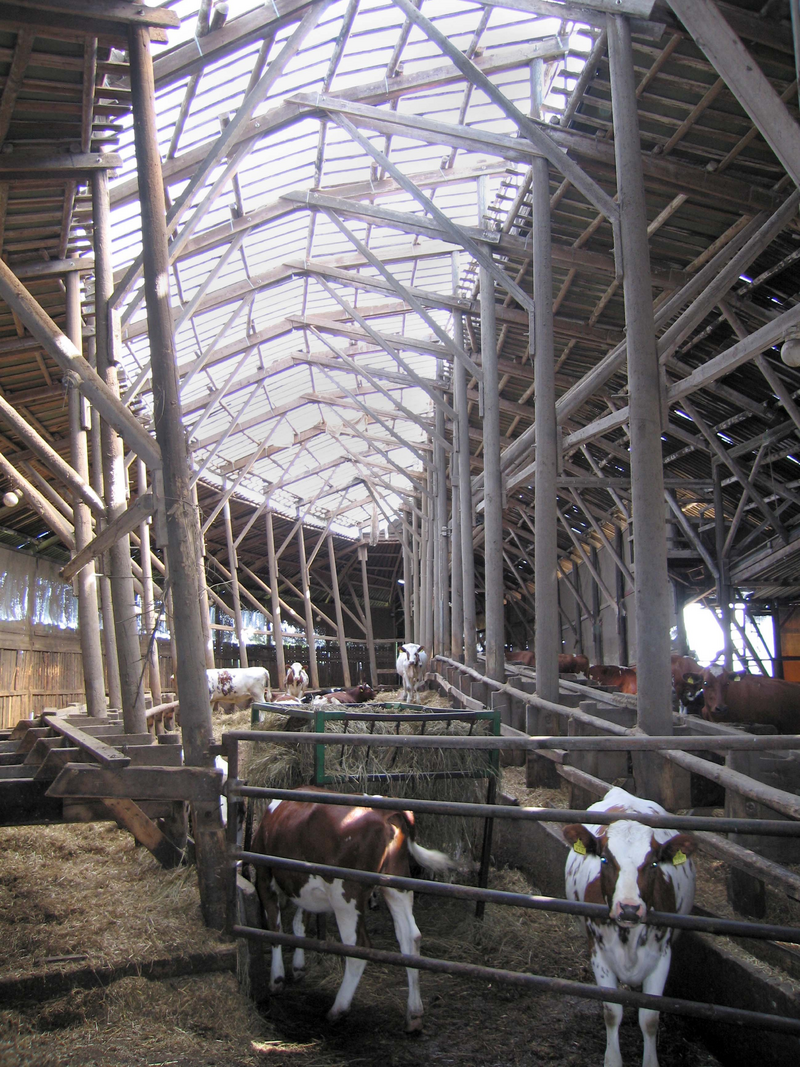
Es gibt auch diesen brillanten Bereich in der Scheune, in der die Kühe die Sterne ansehen können.
J-EA: Natürlich, denn Kühe mögen es, wenn sie nachts die Sterne sehen können, also haben wir das Dach mit altem recyceltem Plastik aus dem Gewächshaus geöffnet. Nun können die Kühe nachts die Sterne sehen.
Und Sie waren an einer Reihe von Projekten und Veranstaltungen rund um essbare Kunst beteiligt … zum Beispiel an der For Arts Night 1993 in Helsinki, einer Art Performance, gemeinsam mit Kari Juutilainien. Sie beide genossen das gleiche Mahl wie das, das der berühmte Maler Axel Gallen-Kallela dem Komponisten Jean Sibelius zu seinem Geburtstag im Jahr 1915 bereitete. Und im Rahmen des Grünen Jahres wurde eine Karotten-Oper, geleitet von Sami Panula, im Pori Art Museum aufgeführt (1995). Außerdem gab es im Lahti Art Museum 2002 eine Ski-Performance, bei der die Ecken durch Lakritz und Marzipan ersetzt wurden. Die Liste lässt sich fortsetzen, ganz so, wie die Edible Finns nach São Paulo, Helsinki, Gent reisten. Sie hatten sogar essbare Kleidung …
J-EA: Alles begann damit, dass sich Kari Juutilainen und ich die große Frage stellten: Wobei hat man immer Spaß, wenn man es tut? Uns fiel essen ein. Essen klingt nett. Essen ist ein Prozess. Wir fingen damit an, eine Situation herzustellen, in der wir einfach nur essen konnten. Leute konnten kommen und uns dabei zusehen. Es war das Konzept der lebenden Skulptur. Dann betrachteten wir den Prozess von einem ökologischen Gesichtspunkt: eine Art Kunst, die keine Spuren hinterlässt. Pertti Toikkanen stellte alle möglichen Arten von Hüten, Handschuhen und biologischen Kleidungsstücken aus Bio-Weizen und Milchsäure her.
Dieses Essensprojekt führte zu vielen kleinen Skandalen. Zu Beginn der 1990er Jahre, als die Rezession in vollem Gang war, nutzen wir öffentliche Gelder, die wir für eine öffentliche Installation erhalten hatten und stellten ein Essensevent mit fantastischem Lapplandessen auf die Beine. Die Leute waren erzürnt! Was machen die Künstler? Beinahe wäre der Stadtarchitekt entlassen worden, weil er uns den Zuschlag gegeben hatte. Aber wäre es denn besser gewesen, das Geld für etwas zu nehmen, das einige Monate später abgerissen worden wäre? Die meisten meiner Projekte sind langfristig und komplex und diese Essensperformances sind meine Art zu entspannen und die Dinge locker anzugehen.
Professionalität ist manchmal ein Problem in der Kunst. Unsere Sprache ist verschlossen und wir müssen die Dinge etwas öffnen, um weiter zu gehen … Können Sie mir daher etwas über das Nest-Projekt erzählen? Eine weitere Ironie Ihrerseits, ein Standardmodul wie eine Maquette zu formen, aber in einem lebensgroßen Format und durch die Verwendung einfacher rechteckiger Formen.
J-EA: Dies entstand auf Grund der Architekturtheorien, mit denen ich mich während meiner Dissertation im Bereich der Schönen Künste befasste. Architekten verwenden viele Module und wegen deren Maße sagen sie, es seien menschliche Module. Sie formen lange Korridore aus diesen Modulen und das ist nicht allzu menschlich. Daher wollte ich mein eigenes Modul schaffen und habe versucht, kontrolliertes Chaos herzustellen. Also formte ich das Dreieck aus Holzstöcken (140 cm x 140 cm x 140 cm) und ich dachte mir: „Warum baue ich das Nest nicht so, wie es Vögel tun?“ So wie die Vögel habe ich die Form im Kopf und ich schraubte ein Dreieck an das nächste, ohne zu messen. Das größte Nest, das ich gebaut habe, ist im Evanston Art Center zu finden und besteht aus 350 Dreiecken. Das Interessante daran ist, dass man nicht sieht, dass es aus einem einzigen Modul besteht und es ist eine sehr stabile Konstruktion! Der Klangkünstler Shawn Decker erstellt jedes Mal ein Geräusch für das Nest, dabei testet er neue Versionen, um Geräusche als Verzierung zu nutzen.
Und Sie sind an N55 in Dänemark beteiligt?
J-EA: Ich versuche offen zu bleiben und sowohl maximalistische als auch minimalistische Energien in mein Leben zu integrieren. Während ich Wild kuratierte, die Ausstellung über Fantasie und Architektur, dachte ich, dass viele der Arbeiten so kompliziert sind, und fragte mich, warum N55 nicht ihre einfachen Lebensmodule für die Ausstellung machen könnten. N55 stellen Anleitungen für alles im Leben ins Internet. Und so schufen sie das Microdwelling, ein Gebäude im Mikroformat, ein Ein-Personen-Apartment-Modul, das man auch ins Wasser versenken kann. Wenn man mag, kann man auch mehrere Module zusammenfügen. Ich selbst habe es finanziert, daher stellte ich es nach der Ausstellung, als eine Art Kontrast, vor das Blatt-Haus.
Was genau ist die Knoblauchstruktur, die Sie auf dem Gelände vor dem Blatt-Haus haben?
J-EA: Die Geräusch-Kuppel-Sauna ist eine Mischung aus Knoblauch und Kürbis. Fünf zeitgenössische Künstler sind an der Sauna-Labor-Ausstellung diesen Sommer beteiligt. Der Gedanke entsprang meinem Interesse an Russisch-Orthodoxen Kirchen und ihren zwiebelförmigen Dächern. Ich wollte eine öffentliche Sauna auf einem grauen Mietshauskomplex errichten. Ich wollte das Ganze mit einer Kuppel verzieren, aber dem wurde nicht stattgegeben. Daher wird es nun in einem öffentlichen Schwimmbad in einem Park stattfinden. Ich habe also immer noch die Idee der Form und des Klangs. Shawn Decker erschafft Klänge für die Sauna, die darauf reagieren werden, wenn man Wasser auf die Heizung gießt. Im Innern kann man einen dröhnenden, meditativen Klang hören und draußen ein witziges dampfendes Geräusch, ganz so wie kochendes Wasser … es wird also eine gänzlich unorthodoxe Saunaerfahrung!
Für die Eco-Art Show des Pori Art Museum haben Sie 2011 eine Struktur gebaut, deren Dach aus Planen und Kleidung von Menschen besteht, die am Blatt-Haus beteiligt waren. Ein starkes und wirkungsvolles soziales Statement.
J-EA: Ich weiß nicht, was ich von der Idee halten soll, ein Haus in einer Ausstellung zu zeigen, aber es gab so viel Interesse an dem Gebäude und die Menschen baten mich, dies zu tun. Ich habe versucht mir etwas zu überlegen und diese Bude ist das Beste, was mir einfiel. Die Videos sind in die Struktur integriert und die Leute können den Beteiligten zusehen, wie sie das Blatt-Haus bauten – das Blatt aus einer Geschichte, das ein Haus wurde.
Bei dem Blatt-Haus geht es letzten Endes um Liebe, Liebe in Beziehungen, Liebe als Gemeinschaft und um Kunst als ein essentieller Bestandteil von Architektur; Architektur als ökologischer, interaktiver Prozess, dessen wahre Ökonomie die Liebe ist. Architektur kann uns alle verbinden, eine geteilte Verbindung, die sich im Blatt-Haus manifestiert.
J-EA: Für mich geht es vor allem um die Liebe zum Detail, die Liebe zur Verzierung, die Liebe des Umsorgens. Ich denke, dass die minimalistisch-rationale Architektur einiges übersieht, da sie dieses fantastische Element ausschließt. Darüber sollten wir auch nachdenken, wenn wir über eine nachhaltige Zukunft sprechen.
Vielen Dank für alles, Jan-Erik! Möge die Macht mit dir sein!
Das Interview wurde am 03. Februar in Turku und am 04. Februar in Pori (beides: Finnland) durchgeführt.
Autor: John K. Grande
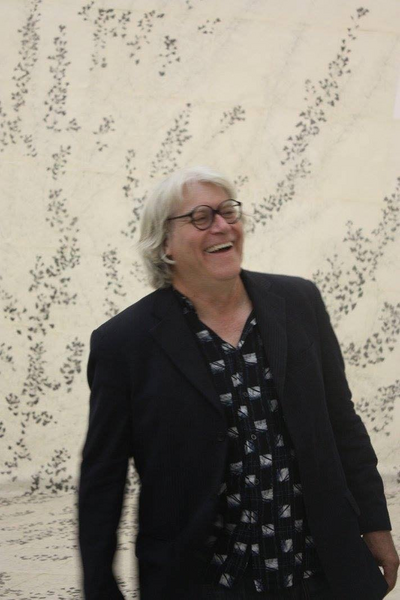
Grande ist Autor einer Reihe von Büchern wie Art & Environment (Friendly Chameleon, Toronto, 1992), Balance: Art and Nature (Black Rose Books, 1994), Intertwining: Landscape, Technology, Issues, Artists (Black Rose Books, 1998), Art Nature Dialogues (SUNY Press, New York 2003) und Dialogues in Diversity; Art from Marginal to Mainstream (Pari, Italien 2007). Er hat weltweit Earth Art Ausstellungen kuratiert, so zum Beispiel in den Royal Botanical Gardens und Van Dusen Gardens in Kanada, im Pori Art Museum in Finnland (2011), in Meran, Tirol, Italien (2014), bei den Pan Am Games in Toronto und an vielen anderen Orten. 2016 kuratierte er Small Gestures in der Mucsarnok / Kunsthalle, Budapest, Ungarn.
